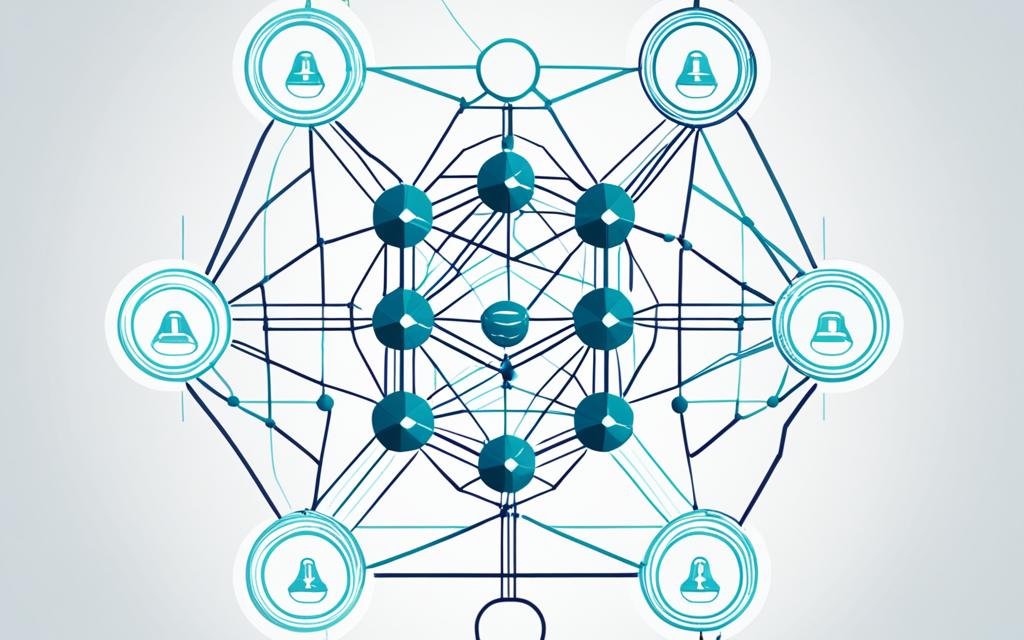Table of Contents
A blockchain node is a type of device, like a computer, that joins a blockchain network. It uses special software to check transactions and make the network safe. By talking to each other, these nodes help make the network decentralized and secure. They are key in keeping the blockchain safe and trustworthy1.
Key Takeaways:
- A blockchain node is a device that participates in a blockchain network, helping validate transactions and ensuring network security.
- Nodes communicate with each other, increasing the decentralization of the network.
- Nodes play a critical role in maintaining the integrity of the blockchain
How Does a Blockchain Node Work?
When we talk about how a blockchain functions, the role of a blockchain node is key. These nodes check transactions and protect the blockchain. They ensure it’s trustworthy and stable.
Validating transactions is a key job for a node. If someone sends money, a node checks if they can afford it and if it’s allowed. This step is crucial for the blockchain’s safety and accuracy.
Also, nodes broadcast the transaction to others. This sharing keeps every node updated. No single group controls the whole network, making it safer and harder to change2.
Nodes also help add transactions to the blockchain. They gather the transactions, create a block, and add it to the chain. This teamwork keeps the blockchain’s data fresh and correct3.
There are different kinds of nodes. Full nodes keep the whole blockchain, needing lots of space and power. Light nodes just hold part of it, but they’re faster. They connect to full nodes for the latest information3.
To run a node, you need good storage, memory, and internet. It also requires regular uptime and updates. This work shows the dedication of those who keep nodes running3.
Nodes are essential for blockchain’s verification and security. They make sure the blockchain is reliable, unchanged, and verifiable4.
Types of Blockchain Nodes
| Node Type | Description |
|---|---|
| Full Nodes | Store the entire blockchain, ensuring complete transaction record and verification. |
| Light Nodes | Store partial blockchain data, linking to full nodes for accurate information and serving as crypto wallets. |
| Masternodes | Validate and store transactions, receiving incentives in the form of the blockchain’s native cryptocurrency. |
| Validator Nodes | Play an active role in the block creation process, validating and appending new blocks to the chain. |
| Archive Nodes | Store the entire historical state of the blockchain network, capturing every intermediate state between blocks. |
| Miner Nodes | Reward miners with cryptocurrency for verifying transactions and mining new blocks. |
| RPC Nodes | Serve as vital access points within a blockchain network, providing essential services. |
Blockchain Nodes and Miners
Blockchain networks work because nodes and miners join forces. Nodes check transactions are real, while miners solve hard puzzles. This process adds more blocks to the chain5. Now, let’s look closer at how nodes and miners help the blockchain.
Nodes and Transaction Validation
In Bitcoin and Ethereum worlds, nodes double-check transactions. They make sure the data is correct and not fake. For instance, Ethereum uses different nodes like full nodes or light nodes for efficient checks5. On the other hand, Bitcoin’s nodes, like full nodes, work together to update the state of its blockchain6.
Miners and Block Confirmation
In the mining game, miners play a big role. They use a lot of computer power to solve puzzles. If they succeed, they add a new block to the chain and get rewarded with new coins6. This setup pushes miners to keep the blockchain safe and sound.
Alternative Consensus Mechanisms
Not all blockchains use mining to check transactions. Some, like R3 Corda, link transactions in a special way for fast checks5. Tezos’ way, called proof of stake, focuses on being efficient and easy to upgrade57.
Diverse Blockchain Networks
Every blockchain offers something different. IBM Blockchain, for example, is popular for its private and secure network that links well with big company tech5. Hyperledger Fabric keeps data safe by isolating transactions in separate channels5. And Hyperledger Sawtooth is flexible, working with many ways to agree on transactions5. EOSIO is great for making new apps easier than Ethereum does, especially for finance apps5. Stellar’s unique way is good for moving money across borders and for finance projects5. Plus, Quorum, backed by JPMorgan, speeds up private transactions, perfect for banks5.
Nodes and miners are key to keeping blockchains safe and running smoothly. They make sure every transaction is right and every block fits the chain properly. Knowing how nodes and miners work together helps us see why blockchain tech is so exciting.
Types of Nodes in Blockchain
In a blockchain network, several types of nodes help keep the system honest and fair. They work together to maintain the decentralised and trustworthy nature of the network.
Archival full nodes keep the entire blockchain ledger. This means they hold all the transactions ever made. They’re vital for checking old transactions and quickly looking up smart contracts.
Pruned full nodes save space by getting rid of old blocks. They keep the network decentralised while still being able to verify transactions accurately8.
Light nodes, or lightweight nodes, only store a basic version of the blockchain. They use full nodes’ help to check transaction history. This saves them a lot of memory space8.
Masternodes keep the main copy of the blockchain. They make sure transactions are valid. With these nodes, the network stays secure and reliable9.
Mining nodes work on solving complex maths problems to create new coins. Their job helps the network stay secure and stable. Miners get rewarded for their work9.
Authority nodes are chosen by blockchain members. They’re in charge of running and managing the network. Their known identities make the network more trustworthy9.
Staking nodes use their own coins as proof in a proof-of-stake system. They check and add new blocks to the network. This keeps the network running safely and smoothly98.
Lightning nodes are key for fast transactions outside the main blockchain. They help increase the number of transactions possible. This is crucial for many businesses that rely on blockchain9.
Running a full node takes specific equipment like a computer and fast internet. You’ll also need to choose between Linux, Mac, or Windows. This ensures your node can handle the blockchain smoothly9.
Setting up a blockchain node means installing and syncing it with the network. You also need to regularly check, manage, and update the node. This makes sure it works well all the time9.
Investing in Blockchain and Fintech
Investing in fintech blends money with new tech, creating exciting chances. Also, blockchain investments let you join the tech behind digital money and more. This mix makes both areas, fintech and blockchain, a smart pick in the fast-growing tech world.
Fintech means using tech to better money services. This field has boomed lately, with over $133 billion pumped into it by 2021’s end10. The blockchain part of fintech is set to reach a value of $10.02 billion by 2022, growing fast10. These stats show a big chance for making money in fintech and blockchain.
Also, blockchain helps banks and such save a lot of money. By cutting out the middlemen, costs go down fast1110. Transactions speed up and are much more visible, making things smoother and cheaper for these firms. This tech also wants to make banking fairer, especially helping folks left out before1112.
Looking at tech investments, you can’t miss how big cryptocurrencies are. They’ve changed the tech world tons in the last decade12. By using blockchain, banks and other financial firms get more secure and faster transactions. Tasks can also get done on their own, saving time and money12. This helps more people get into banking, doing a lot of good in poorer parts of the world12.
If you’re thinking about putting your money in tech, fintech, or cryptocurrencies, it pays to watch the trends and news. With this info, making smart investment choices becomes easier. Keeping an eye on what’s happening can lead to good returns in these fast-moving areas.
How to Create Nodes in Blockchain
Setting up a blockchain node is easier than you think. You first need the right hardware, such as a dedicated device. Or you can use your computer with enough memory. Next, download and install the required software on your machine. It’s vital to regularly run the software to keep your node updated. Remember, when setting up, think about the hardware, internet connection, and the blockchain’s needs.
Setting up an Ethereum node in Blockchain Node Engine takes about 30 minutes. This time doesn’t include the sync time, which could take up to a day13. You’ll define your node with a name, choose blockchain and network types, and specify the client, and region for hosting resources13. For example, you can select configurations like FULL MAINNET GETH LIGHTHOUSE or ARCHIVE MAINNET ERIGON LIGHTHOUSE13.
If you use an API to set up a node, you might want to use the Private Service Connect feature13. You can also set a Beacon Fee Recipient on the client. This is crucial for when a fee recipient isn’t set by the validator client13. The address for the Beacon Fee Recipient should start with “0x”13.
Some nodes offer a managed MEV-boost service. This service lets you access external block builder services using MEV-relay URLs13. Besides, special Validator Configuration options are accessible via the API. This is for customers using Blockchain Node Engine with a managed validator client13.

| Blockchain | Hardware Requirements | Internet Requirements | Storage Requirements |
|---|---|---|---|
| Bitcoin | Minimum 8 GB of RAM | Minimum download speed of 400 KB/s | 750 GB of free disk space |
| Ethereum | Minimum 8 GB of RAM | – | 500 GB of storage for full mode (SSD recommended) |
Creating nodes in blockchain means focusing on the right hardware, internet, and storage. For an Ethereum or Bitcoin node, you must have enough RAM. Bitcoin, for instance, needs 8 GB, while Ethereum requires the same. A fast internet connection is crucial for Bitcoin, at least 400 KB/s. But Ethereum doesn’t have a specific speed requirement. Speaking of storage, Bitcoin nodes need 750 GB, whereas Ethereum in full mode needs 500 GB on an SSD. These details are essential for a smooth blockchain experience14.
Building a blockchain node can be costly and require expertise15. It entails expenses like personnel and technology. Yet, opting for third-party services can reduce such costs15. Cloud solutions provide flexibility but have their own pricing factors linked to usage and stability15.
Key Steps to Create a Blockchain Node:
- Choose the appropriate hardware: Establish the hardware needs based on the specific blockchain. This should include RAM, storage space, and other requirements.
- Install the blockchain node software: Get the correct software for the blockchain you’re joining. Follow the installation guide closely.
- Configure the node: Provide the necessary information such as node name and location. Also, select your blockchain type and network.
- Ensure regular software updates: It’s crucial to update the node software with the latest downloads. This keeps your node secure.
- Maintain connectivity: Always have a stable internet connection. This is vital for your node to stay synced and active in the network.
By completing these steps, anyone can create and run a blockchain node13. You might choose to support the Bitcoin network with its over 11,000 nodes15. Or get involved in Ethereum, which has 6,447 active nodes15. Setting up a node is your entry into the world of crypto. It lets you participate and help secure the network.
Why Are Blockchain Nodes Needed?
Blockchain has changed how many industries work. It provides a network without a central point, keeping transactions safe and removing middlemen. Blockchain nodes are key parts of this system. They help the network run smoothly and protect its key values of being decentralised, secure, and trustworthy.
These nodes are like the network’s support system. They work together to check and confirm transactions. Each node is its own unit, keeping a blockchain copy and making sure transactions are correct. This setup stops any one person or group from fully controlling the network, keeping it safe from cheating and hacks.
Nodes ensure the blockchain stays true. They check all transactions to stop fake ones from being added. This step fights fraud and keeps the network honest. Plus, having many nodes all over makes the network tough to attack, adding a bonus layer of security.
But there’s more to it. Blockchain nodes also mean the network isn’t run by just one boss. In traditional set-ups, central authorities have all the power. With nodes, everyone who participates has a say. This makes everything more open and fair, as changes need agreement from many.
Nodes also help the network grow and work better. Take the Algorand network, for example, with its 110 relay nodes16. There are special types of nodes for different jobs. Archival nodes keep the old records, while non-archival nodes just hold recent info. This split helps keep things running well and use less space16. Algorand even made starting and using nodes easier with AlgoRun. This lets more people join in, widening blockchain’s reach.
So, blockchain nodes do a lot to keep the network strong and true. They watch over the transactions, make sure no one pulls the strings alone, and help the network grow smoothly. As blockchain tech gets bigger, these nodes will stay a key part, shaping the future of how we all use tech.
Functions of Blockchain Nodes
Blockchain nodes do a lot to keep the network safe and running well. They make sure the blockchain is secure. They also help keep everyone using the blockchain on the same page.
Nodes look at new transactions to check they are real and correct. This stops any fake transactions before they cause harm.
1. Securing the Blockchain
Securing the blockchain is a key job for blockchain nodes. They check all new transactions to make sure they aren’t fake. This makes the blockchain safe and trustworthy.
2. Maintaining Blockchain Consensus
Keeping the blockchain right is crucial, and nodes work together to do this. They make sure every new piece of information about transactions is added everywhere at the same time. This way the blockchain stays accurate for all its users.
3. Validating Transactions
Nodes also check if new transactions mean the rules. They see if the person sending money really has it. This helps stop scams and makes sure all transactions are true.
4. Storing Blockchain Data
Storing the blockchain’s data is another big job for nodes. Each node has a copy of all the transactions ever made. This info is open to everyone, which helps make the blockchain reliable.
For quick access to certain parts of the blockchain, some nodes store just a bit of it. This makes finding specific information faster. For example, some save only the most recent actions to save space.
Statistical data from reference17: There are 10 types of blockchain nodes. These include full, archival, authority, miner, staking, master, pruned full, light, lightning, and super nodes.
Archival full nodes are detailed into different roles like authority and mining nodes. Each has a clear job. Meanwhile, pruned full nodes help by keeping the blockchain up to date without storing all its history.
In the end, blockchain nodes are key to how the whole system works. They make the blockchain secure, trustworthy, and always up to date. Understanding their roles helps us see the importance of blockchain technology.
Blockchain Nodes in Different Blockchain Networks
Blockchain nodes are key in networks like Ethereum, Bitcoin, and more. They help keep transactions secure, decentralised, and transparent. Each network uses nodes uniquely to make sure they work well and are safe18.
Ethereum
In Ethereum, nodes act as participants who check and store transactions. They are vital for the network’s health and to check smart contracts. Ethereum uses Proof of Work. This means nodes solve hard puzzles to say transactions are good and safe19.
Bitcoin
Bitcoin’s strength comes from many nodes checking its blockchain. These nodes hold all transaction records and make sure they’re correct. Bitcoin uses Proof of Work too. Nodes compete to solve puzzles, making the system strong and without weak points19.
R3 Corda
R3 Corda helps private, safe transactions through its nodes. Each node only deals with what matters to it. Corda gets everyone on board rather than the whole network to agree. This keeps things private and helps it grow well18.
IBM Blockchain
IBM Blockchain cuts risks in business deals with its nodes. These nodes help agree on deals, check them, and keep them safe. It’s made for big business, with very good safety in mind18.
Hyperledger Fabric
Hyperledger Fabric is great for private blockchains with its nodes. They do jobs like keeping the records, doing deals, and checking their sense. Its set-up is flexible. It lets groups change it to fit what they need18.
Tezos
Tezos looks after itself with nodes that use smart contracts. These nodes help agree on what’s true through staking. They can even fix things without big changes. This keeps Tezos running smoothly and up-to-date19.
EOSIO
EOSIO is about fast, big apps thanks to its nodes. Elected nodes make sure deals are good and start the next round. It’s designed to be quick and grow with the demand19.
Stellar
Stellar moves fast with the help of its nodes. They keep everything in line and share what’s agreed on. It’s a special way of agreeing called SCP that’s quick and reliable18.
ConsenSys Quorum
ConsenSys Quorum mixes big network safety with the needs of a business boardroom. It uses nodes for private deals. This way, it’s good for special business blockchain projects18.
Different blockchain networks rely on nodes for many things. They keep things safe, fair, and running smoothly. Through these nodes, groups can use blockchain for open, safe, and better ways to do business.
How to Create a Blockchain Using Node.js
Creating a blockchain with Node.js lets developers make powerful, custom applications. Node.js has lots of tools and libraries. This means developers can make strong and safe blockchain solutions that fit their needs.
To make a blockchain using Node.js, just follow these steps:
Step 1: Set up Your Environment
First, make sure you have Node.js on your computer. It’s great for running JavaScript on servers, perfect for blockchains. You can download it from the official Node.js website20.
Step 2: Initialize a Node.js Application
After installing Node.js, start a new project by typing npm init in your terminal. This sets up a package.json file. It helps your project manage its dependencies.
Step 3: Install Dependencies
You need to install a few things to start your blockchain with Node.js. These are crypto-js, express, and web3.js21. Use the following commands in your terminal to install them:
npm install crypto-jsnpm install expressnpm install web3
Step 4: Write the Necessary Code
Now you can write the code. You’ll set up how your blockchain’s blocks work. You’ll create a Blockchain class, add data endpoints, and keep the chain secure21.
Step 5: Test and Deploy
Test your blockchain well to make sure it works right. Check all its features to catch and fix bugs. After testing, you can put it into use for your projects.
That’s how you make a blockchain using Node.js. Remember, there are many tutorials and guides online. For more help, you can check out Smashing Magazine, CoinMonks, and Vivek Moradiya’s post on Medium202122.
References:
- 20 “Cryptocurrency Blockchain with Node.js,” Smashing Magazine
- 21 “Setup Blockchain Network Using Node.js,” CoinMonks
- 22 “Building a Blockchain Application with Node.js: A Step-by-Step Guide,” Vivek Moradiya on Medium
| Statistical Data | Description |
|---|---|
| Percentage increase in the adoption of Node.js for blockchain development compared to traditional Python. | Node.js has seen more use in blockchain, beating out Python. It’s a popular choice now20. |
| Number of specific industries experiencing increased adoption of blockchain technology. | More industries are using blockchain. They see its benefits and are jumping on board20. |
| Ratio of JavaScript developers exploring cryptocurrency development using Node.js. | JavaScript developers like using Node.js for their cryptocurrency projects. It’s their top pick20. |
| Increase in complexity of mathematical equations required for mining new blocks as the blockchain grows. | As blockchains get bigger, the math for mining gets harder. It’s like a puzzle that gets tougher20. |
| Frequency of consensus protocols like proof of work being applied in various blockchain networks. | Many blockchains use proof of work to keep things secure and working well20. |
| Comparison of the number of cryptographic hash calculations required for validating new blocks in different blockchain implementations. | The amount of math needed to check new blocks varies between different blockchains20. |
Conclusion
Blockchain nodes are key parts of a blockchain network. They help with security, validation, and making the system decentralized. Nodes are important for keeping the network honest and agreeing on what transactions are valid. They also store the history of transactions safely.
By knowing about nodes, we can understand blockchain better. This knowledge is useful for people who want to invest or work with blockchain.
Making and looking after a node is a big help for the blockchain world. The more nodes there are, the stronger and more reliable the network becomes. Full nodes in Ethereum need fast computers, lots of memory, and big hard drives. This is because they keep a lot of data, and this data keeps growing.
All nodes in a blockchain network have different jobs. For example, some focus more on safety. They only keep the most recent transaction records. Others, like archive nodes, save all the information since the start. Staking nodes help confirm transactions. They put up some of their cryptocurrency as a promise that they’re acting honestly.
Authority nodes are special. They are carefully chosen to run some networks. Master nodes also play a big role in checking transactions. They help decide how the blockchain is run. Miner nodes are different. They make sure new transactions are written to the blockchain. They get rewarded for this with new coins.
There are also lightning nodes. They make it possible to do some transactions off the main blockchain. This can make transactions faster and cheaper.
To wrap up, nodes are critical for making sure blockchain networks work well. They do different jobs but all help keep the network safe and fair. As blockchain grows, the role of nodes will become even more important. They will open up new chances both for investment and creating new digital projects.
The numbers2324,, and25 show where specific data was used. This helps us understand more about the points made in this section.
FAQ
What is a blockchain node?
A blockchain node is a computer that helps a network work. It uses special software to check transactions and make sure the network is safe.
How does a blockchain node work?
It checks if transactions are valid and secure. Users send transactions, which nodes share with the whole network. Then, they confirm and add these transactions to the blockchain.
What are blockchain nodes and miners?
Nodes and miners do different tasks for transactions. Nodes check if transactions are okay. Miners work to add these transactions to the blockchain and get rewarded with cryptocurrency.
What types of nodes exist in blockchain?
Blockchain networks have many types of nodes. These include full nodes, light nodes, and more. Each type helps the network in unique ways.
What is the importance of investing in fintech and blockchain?
Investing in fintech and blockchain mixes money with new tech. It can jumpstart growth in both valuable companies and tech advances. These areas open doors to investing and exploring what’s new in the tech world.
How can I create a blockchain node?
Creating a blockchain node requires good hardware and software. You also need a strong internet connection for it to work well.
Why are blockchain nodes needed?
Nodes are key to keeping a blockchain safe and reliable. They make sure transactions are valid and add blocks to the chain. This process helps keep the network in trustable shape.
What functions do blockchain nodes perform?
Nodes help in many ways. They keep the network safe, verify transactions, and make sure blockchain data is available to all. This keeps the network working smoothly.
Which blockchain networks utilize nodes?
Many networks like Ethereum and Bitcoin use nodes. They’re also found in R3 Corda and other big names. Each network uses nodes differently to manage the technology.
How can I create a blockchain using Node.js?
To start, set up your working area. Then, create a Node.js application and add the code for a blockchain. Node.js is great for building powerful blockchain systems.
Source Links
- https://builtin.com/blockchain/blockchain-node – What Are Blockchain Nodes and How Do They Work? | Built In
- https://www.chainnodes.org/blog/everything-you-need-to-know-about-blockchain-nodes – Everything You Need To Know About Blockchain Nodes
- https://worldcoin.org/articles/what-is-a-blockchain-node – What’s a Blockchain Node?
- https://shardeum.org/blog/what-is-a-blockchain-node/ – Blockchain Node – Working, Importance and Types | Shardeum
- https://www.blockchain-council.org/blockchain/blockchain-nodes/ – Blockchain Nodes
- https://river.com/learn/what-is-a-bitcoin-node/ – What Is a Bitcoin Node? | River Learn – Bitcoin Technology
- https://www.ledger.com/academy/what-is-a-node-and-why-should-i-operate-one – Crypto Nodes: What Are They And How Do They Work? | Ledger
- https://polymesh.network/blog/types-of-blockchain-nodes-explained – Types of blockchain nodes, explained
- https://www.guru99.com/what-is-a-node.html – Types of Node in Blockchain
- https://www.techmagic.co/blog/how-blockchain-evolutionise-fintech-market/ – How Blockchain Is Revolutionizing Fintech Industry | TechMagic
- https://www.forbes.com/sites/forbestechcouncil/2023/01/31/how-fintech-and-blockchain-are-evolving-and-disrupting-financial-institutions/ – Council Post: How Fintech And Blockchain Are Evolving And Disrupting Financial Institutions
- https://keenethics.com/blog/blockchain-in-fintech – Blockchain in Fintech: Use Cases and Future | Keenethics
- https://cloud.google.com/blockchain-node-engine/docs/create-node-ethereum – Create an Ethereum blockchain node
- https://blog.rockx.com/set-up-blockchain-node/ – A Beginner’s Guide to Setting up a Blockchain Node – RockX
- https://www.infoq.com/articles/blockchain-as-a-service-get-block/ – Blockchain Node Providers and How They Work
- https://www.algorand.foundation/news/what-is-a-node-in-blockchain – What Is a Node in Blockchain? | Algorand Foundation News
- https://blog.binance.us/crypto-nodes/ – No title found
- https://www.kaleido.io/blockchain-blog/blockchain-nodes-what-you-need-to-know – Blockchain Nodes: What You Need to Know
- https://nodes.com/ – Blockchain Nodes: How They Work (All Types Explained)
- https://www.smashingmagazine.com/2020/02/cryptocurrency-blockchain-node-js/ – How To Build A Simple Cryptocurrency Blockchain In Node.js
- https://medium.com/coinmonks/setup-up-blockchain-network-using-node-js-2ee3bd3d359c – Setup up Blockchain Network using Node.js
- https://vivekmoradiya.medium.com/building-a-blockchain-application-with-node-js-a-step-by-step-guide-4f1c8ba810dd – Building a Blockchain Application with Node.js: A Step-by-Step Guide
- https://www.identity.com/what-is-a-blockchain-node/ – What Is a Blockchain Node? Complete Overview
- https://ekremkurt1907.medium.com/what-is-a-blockchain-node-5cbb52c30a67?source=rss——blockchain-5 – What is a Blockchain Node?
- https://101blockchains.com/blockchain-nodes/ – Blockchain Nodes: An In-Depth Guide









